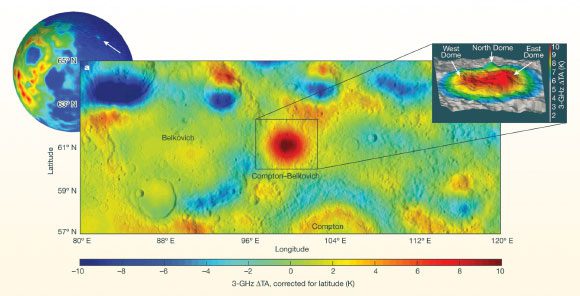On the far side of the Moon, a region invisible from Earth, a structure measuring 50 km in diameter could overturn everything we believed about this celestial body.
According to Sci-News, this is a granite rock system, something never before found on any other celestial body in the Solar System, except for Earth.
The structure was discovered in an area named the Compron-Belkovich Volcanic Complex, which likely formed from the cooling of molten lava that fueled one or more volcanic eruptions around 3.5 billion years ago.

Anomalous feature recently discovered on the Moon through remote sensing data – (Photo: NATURE).
Previously, NASA’s Apollo missions found a small amount of granite grains, believed to originate from Earth. This aligns with the most robust hypothesis about the Moon’s origins, which posits that a Mars-sized planet collided with primordial Earth, resulting in debris from both bodies forming this satellite.
However, this new discovery indicates that the Moon must possess its own granite.
“Typically, granite requires tectonic plate processes or water-rich magma to form. Although the Moon’s interior contains a small amount of water, it has never undergone plate tectonics. Therefore, the discovery of this granite complex suggests that some poorly understood processes are responsible for its formation,” said Professor Timothy Gloch from Stony Brook University (USA).
Meanwhile, his colleague, Dr. Matthew Siegler from the Planetary Science Institute, noted that any large granite mass on Earth has historically been a power source for a series of major volcanic activities.
The geographic range of this structure suggests that many similar formations could occur on the Moon, indicating that this celestial body’s geological activity is more mysterious than we previously thought, with many cycles surprisingly akin to those on Earth.
This discovery, published in the journal Nature, promises to provide significant advancements in understanding the truths about Earth’s enigmatic satellite, where some previous studies even suggested the potential for past life. Geological activity is one of the key factors contributing to a habitable celestial body.




















































